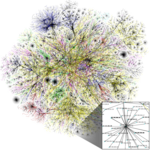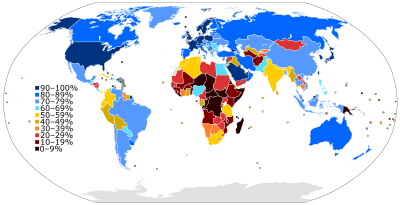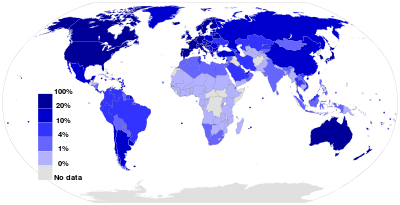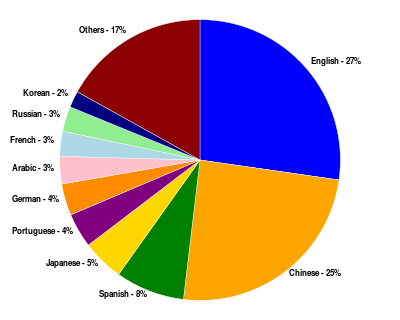此条目为全球互联网使用率,整合了有关表格、图表、地图以及使用率等条目或资料。
 每100名人口的网络使用者资料来源:国际电信联盟[1][2]
每100名人口的网络使用者资料来源:国际电信联盟[1][2]
全球互联网使用者
| |
2005年 |
2010年 |
2014年a
|
| 世界人口[3]
|
65亿
|
69亿
|
72亿
|
| 无使用互联网
|
84%
|
70%
|
60%
|
| 有使用互联网
|
16%
|
30%
|
40%
|
| 发展中国家的使用者
|
8%
|
21%
|
32%
|
| 发达国家的使用者
|
51%
|
67%
|
78%
|
a估计
资料来源:国际电信联盟[4]
|
|
各区域之互联网使用者
|
|
2005年
|
2010年
|
2014年a
|
| 非洲
|
2%
|
10%
|
19%
|
| 美洲
|
36%
|
49%
|
65%
|
| 阿拉伯国家
|
8%
|
26%
|
41%
|
| 亚太地区
|
9%
|
23%
|
32%
|
| 独立国家联合体
|
10%
|
34%
|
56%
|
| 欧洲
|
46%
|
67%
|
75%
|
a估计
资料来源:国际电信联盟[4]
|
|
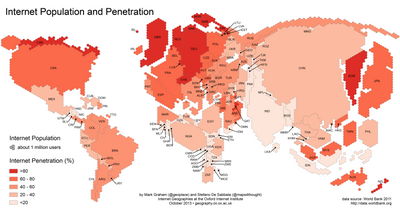 2011年互联网使用者数量资料来源:牛津大学互联网研究所信息地理学[6]
2011年互联网使用者数量资料来源:牛津大学互联网研究所信息地理学[6]
全球宽频用户
|
|
2007年
|
2010年
|
2014年a
|
| 世界人口[3]
|
66亿
|
69亿
|
72亿
|
| 固定宽频
|
5%
|
8%
|
10%
|
| 发展中国家
|
2%
|
4%
|
6%
|
| 发达国家
|
18%
|
24%
|
27%
|
| 移动宽频
|
4%
|
11%
|
32%
|
| 发展中国家
|
1%
|
4%
|
21%
|
| 发达国家
|
19%
|
43%
|
84%
|
a估计
资料来源:国际电信联盟[4]
|
|
|
各区域之宽频用户
| 固定宽频:
|
2007年
|
2010年
|
2014年a
|
| 非洲
|
0.1%
|
0.2%
|
0.4%
|
| 美洲
|
11%
|
14%
|
17%
|
| 阿拉伯国家
|
1%
|
2%
|
3%
|
| 亚太地区
|
3%
|
6%
|
8%
|
| 独立国家联合体
|
2%
|
8%
|
14%
|
| 欧洲
|
18%
|
24%
|
28%
|
| 移动宽频:
|
2007年
|
2010年
|
2014年a
|
| 非洲
|
0.2%
|
2%
|
19%
|
| 美洲
|
6%
|
23%
|
59%
|
| 阿拉伯国家
|
0.8%
|
5%
|
25%
|
| 亚太地区
|
3%
|
7%
|
23%
|
| 独立国家联合体
|
0.2%
|
22%
|
49%
|
| 欧洲
|
15%
|
29%
|
64%
|
a估计
资料来源:国际电信联盟[4]
|
|
 2011年宽频承受力资料来源:牛津大学互联网研究所信息地理学[6]
2011年宽频承受力资料来源:牛津大学互联网研究所信息地理学[6]
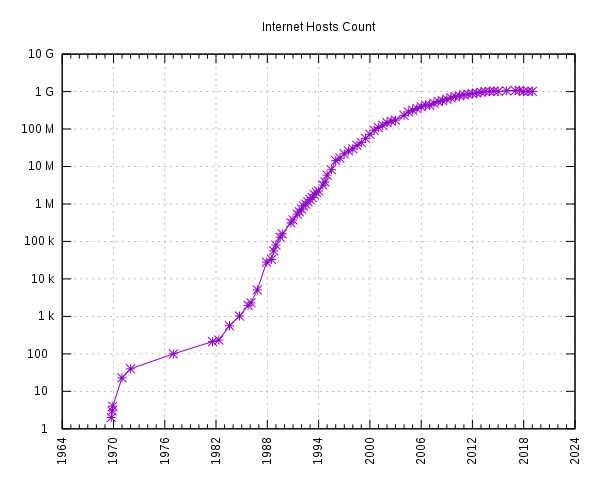 资料来源:互联网系统协会[9]
资料来源:互联网系统协会[9]
卡尔纳僵尸网络为骇客以“2012年互联网普查”的名义使用骇客技术对420,000名用户进行网络使用调查[10][11]。
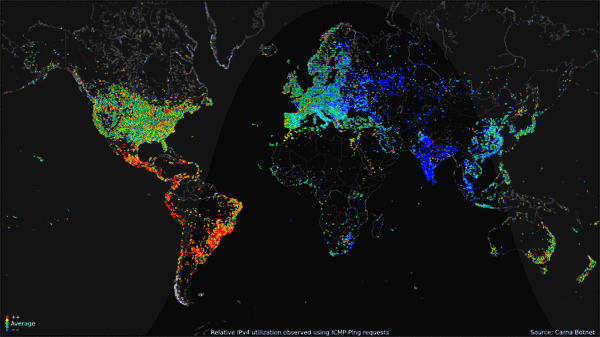 24小时相对平均量世界地图(2012年互联网普查图,2012年6月-10月)[12]
24小时相对平均量世界地图(2012年互联网普查图,2012年6月-10月)[12]
颜色说明:红色(高); 黄或绿色(中);淡蓝或深蓝色(低)
 各国网络审查与监视情形
各国网络审查与监视情形 | 严厉的审查及(或)监视 较严厉的审查及(或)监视 选择性审查及(或)监视 | 依局势而变化 很少或无审查及(或)监视 无归类/无资料 |
资料来源:开放网络促进会[15]、无国界记者[16][17] 目前全世界大约54.4%的人使用互联网[18]。根据国际电信联盟的资料,2018年底将会有约40亿人或是全世界一半的人口可以连线上网,其中包含约20亿名来自发展中国家以及8900万名来自未开发国家的人。在未来,将会有约80%来自发达国家以及34%来自发展中国家的家庭可以连线上网[19][20]。
- ^ "Individuals using the Internet 2005 to 2014" (页面存档备份,存于互联网档案馆), Key ICT indicators for developed and developing countries and the world (totals and penetration rates), 国际电信联盟 (ITU). Retrieved 25 May 2015.
- ^ "Internet users per 100 inhabitants 1997 to 2007" (页面存档备份,存于互联网档案馆), ICT Data and Statistics (IDS), 国际电信联盟(ITU). 2015-05-25.
- ^ 3.0 3.1 "Total Midyear Population for the World: 1950-2050", International Programs Center for Demographic and Economic Studies, U.S. Census Bureau. 2014-05-24.
- ^ 4.0 4.1 4.2 4.3 ICT Facts and Figures 2005, 2010, 2014, 电信发展局, 国际电信联盟(ITU). 2014-05-24. 引用错误:带有name属性“ITCFactsAndFigures-2014”的
<ref>标签用不同内容定义了多次
- ^ 5.0 5.1 "Percentage of Individuals using the Internet 2000-2012" (页面存档备份,存于互联网档案馆), International Telecommunications Union (Geneva), June 2013, retrieved 22 June 2013 引用错误:带有name属性“ITU-IndividualsUsingTheInternet”的
<ref>标签用不同内容定义了多次
- ^ 6.0 6.1 "Internet Population and Penetration 2011" (页面存档备份,存于互联网档案馆), Information Geographies at the Oxford Internet Institute. 引用错误:带有name属性“InternetPopulation2011”的
<ref>标签用不同内容定义了多次
- ^ "Fixed (wired)-broadband subscriptions per 100 inhabitants 2012" (页面存档备份,存于互联网档案馆), Dynamic Report, ITU ITC EYE, 国际电信联盟. 2013-06-29.
- ^ "Active mobile-broadband subscriptions per 100 inhabitants 2012" (页面存档备份,存于互联网档案馆), Dynamic Report, ITU ITC EYE, 国际电信联盟. 2013-06-29.
- ^ "Internet host count history" (页面存档备份,存于互联网档案馆), 互联网系统协会, accessed September 2011, New link "Internet Domain Survey" (页面存档备份,存于互联网档案馆)
- ^ Stöcker, Christian; Horchert, Judith. Mapping the Internet: A Hacker's Secret Internet Census. Spiegel Online. 2013-03-22 [2015-10-04]. (原始内容存档于2015-10-02).
- ^ Kleinman, Alexis. The Most Detailed, GIF-Based Map Of The Internet Was Made By Hacking 420,000 Computers. Huffington Post. 2013-03-22 [2015-10-04]. (原始内容存档于2015-09-27).
- ^ "Internet Census 2012: Port scanning /0 using insecure embedded devices" (页面存档备份,存于互联网档案馆), Carna Botnet, 2012
- ^ Usage of content languages for websites. W3Techs.com. [2013-04-26]. (原始内容存档于2012-03-31).
- ^ "Number of Internet Users by Language" (页面存档备份,存于互联网档案馆), Internet World Stats, Miniwatts Marketing Group, 31 May 2011, accessed 22 April 2012
- ^ OpenNet Initiative "Summarized global Internet filtering data spreadsheet" (页面存档备份,存于互联网档案馆), 2011-11-08、"Country Profiles" (页面存档备份,存于互联网档案馆), the OpenNet Initiative is a collaborative partnership of the Citizen Lab at the Munk School of Global Affairs, University of Toronto; the Berkman Center for Internet & Society at Harvard University; and the SecDev Group, Ottawa
- ^ "Internet Enemies" (页面存档备份,存于互联网档案馆), Enemies of the Internet 2014: Entities at the heart of censorship and surveillance, 无国界记者(巴黎), 2014-03-11.
- ^ Internet Enemies (页面存档备份,存于互联网档案馆), 无国界记者(巴黎), 2012-03-12.
- ^ 存档副本. [2015-10-04]. (原始内容存档于2011-06-23).
- ^ 存档副本. [2015-10-04]. (原始内容存档于2015-09-25).
- ^ 存档副本 (PDF). [2015-10-04]. (原始内容存档 (PDF)于2015-08-12).
- "ICT Data and Statistics"(页面存档备份,存于互联网档案馆), 国际电信联盟(ITU)。
- Internet Live Stats(页面存档备份,存于互联网档案馆), Real Time Statistics Project.
- Internet World Stats: Usage and Population Statistics(页面存档备份,存于互联网档案馆), Miniwatts Marketing Group.
- "40 maps that explain the internet"(页面存档备份,存于互联网档案馆), Timothy B. Lee, Vox Media, 2014-06-02
- "Information Geographies"(页面存档备份,存于互联网档案馆), Oxford Internet Institute.
- "Internet Monitor"(页面存档备份,存于互联网档案馆), a research project of the Berkman Center for Internet & Society at Harvard University to evaluate, describe, and summarize the means, mechanisms, and extent of Internet access, content controls and activity around the world.
